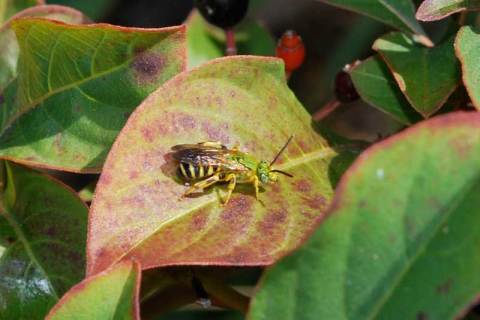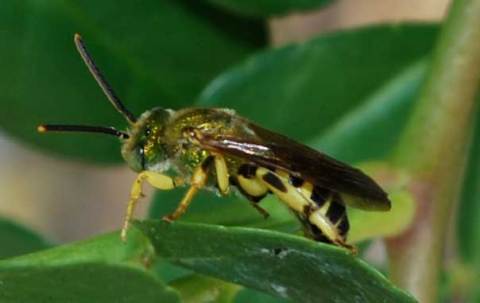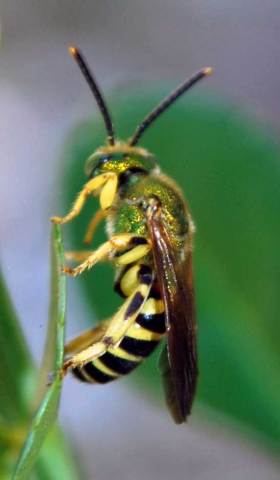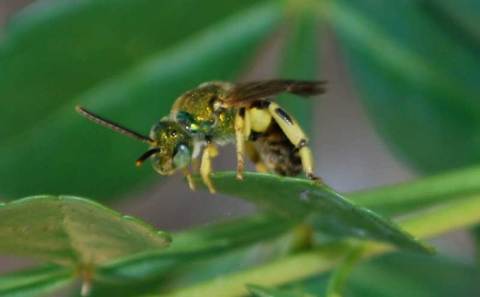The other day I was able to grab a couple of images of a “sweat bee,” the common but too-broad name for members of the Halictid family in the order Hymenoptera. They look like a cross between a bee (hairy) and a wasp (longer thorax, wasp waist), and many of them (the “little green bees,” as Eric Grissell calls them) come in vibrant and metallic colors. “True” sweat bees get their name from the way they land on people and try to harvest their sweat for the moisture and salts it contains; the little green bees, on the other hand, seem to prefer nectaring on flower sources, even though they’re in the same halictid subfamily: the halictinae.
One of these halictids has been particularly prevalent in the garden for the past week or so: Agapostemon sp. There are 43 species of Agapostemon in North America, but Florida, as usual, has what is known as a “depauperate fauna,” with, depending on which source you believe, only two (bugguide.net) or three (discoverlife.org) species in the genus: A. splendens and A. texanus according to bugguide, and A. splendens, A. sericeus, and A. virescens according to discoverlife. The two sources agree that A. splendens is the overwhelmingly more likely ID; there are no records in south Florida for texanus, sericeus, or virescens. I posted the pictures on bugguide as I do with any unknown insect, and they have been referred for expert opinion, but I’m suspecting it’s just to confirm it as A. splendens, not to propose some other bee.
The entire genus is characterized by rapid flight: in the words of the Xerces society,
A fast-moving metallic green blur over summer flowers is probably an Agapostemon.
And it’s true; they flash from flower to flower in a heartbeat, making it quite a challenge to capture an image. I did manage a few, though, which I thought might be fun to share.
Here is one on a firebush leaf, showing off its brilliant colors in full sunlight:
Here are some more close-up views, but unfortunately in flash-filled shade instead of that beautiful full sun from the previous picture. The “classic” side view:
And a vertical image:
And in this last shot, if you squint really hard you can make out what appears to be an ovipositor folded up under the belly. This individual was spending a lot of time trying to get its abdomen in contact with the leaf it was on (Wild lime, Zanthoxylum fagara, in case you’re interested):
You’ll notice that I said “appears to be” an ovipositor; it isn’t. I’m not sure what that structure is, or why this male bee was trying to hump my lime tree, but it ain’t no female bee, so that ain’t no ovipositor. Females have pollen-collecting hairs, and they are green, not yellow, on the abdomen.
If you want to see some beautiful pictures of these bees, take some time to look through the images at bugguide.net, like this one from Sean McCann, or this one by Jeff Hollenbeck, or this one by Tim Lethbridge taken at Archbold Biological Station.




